#post-synthesis/control ending
Explore tagged Tumblr posts
Text
Do not upset a Reaper while you're on a ship and both meandering about in space, it might get huffy and grab onto you.
#commentary#tosses your ass to the closest relay to your homeplanet#“go back home and learn some manners”#mass effect#post-synthesis/control ending
6 notes
·
View notes
Note
Sorry if you've answered this before, but what's your opinion on post-canon Doug? As in, after he's lost all his memories? Do you like to imagine that he regained all of his memories after some time, or that the crew maybe just helped him settle back in? Do you imagine his personality changing dramatically, or staying mostly the same?
hi, first of all, i'm so sorry this took me months to reply to. by now, maybe you've seen some of my other posts about eiffel's memory (there are a lot of them!) and this might be mostly me repeating myself, but i don't mind re-answering questions, and this one in particular is something i come back to a lot. for obvious reasons.
i think eiffel will regain his memories; in my mind, he's only without them for maybe... at most, six months? to me, it makes the most narrative + thematic sense to treat it like lovelace's death: it's a catalyst for character growth, it sort of forces a synthesis of those themes of identity + autonomy + accountability. eiffel is a man who has spent his entire life trying not to face the person he's been, trying to narrativize and step outside of himself to avoid the guilt and the responsibility of his past mistakes. the show repeatedly holds him to account for this behavior. even within the structure of the finale: he's confronted with his memories, trapped inside of himself, and then confronted with his logs, trapped outside of himself. ... then what?
there are a few plausible options for the "how" of it: lovelace's blood is still in his system, it broke him free from pryce's mind control - on a delay, even - memory is clearly something the dear listeners can replicate, there's nothing to say it would treat something like memory loss any differently than something like decima or lost fingernails. alternately: pryce scanned eiffel's memories back in episode 55, and that scan could easily have been backed up somewhere at canaveral. however it plays out, i think there's something compelling about the idea of it being eiffel's choice to regain his memories and to be doug eiffel again, for how that parallels lovelace, for how it mirrors hera choosing not to give up her memories in memoria, and for how it sort of... expands the way late-series wolf 359 "equalizes" the treatment of other characters' minds, especially eiffel's, to emphasize that hera is not as different - and not as doomed - as she's been led to believe.
(i've said before that i'd want eiffel to regain his memories through an "eiffel version of change of mind", which i've elaborated on here. short version: i think he has to confront all these different versions of who doug eiffel is, good and bad, and accept that they're all doug eiffel, in order to move forward, and to set things right as much as he can.)
i think it's notable that eiffel first asks, "am i still that same person [in the logs]?" and then, at the end, "am i still doug eiffel?" because those are different questions with different answers. the eiffel he was right before losing his memory was not that same person. minkowski is also not the person she was during succulent rat-killing tar, that's just kind of... how it is to be a person. but is he still doug eiffel? well...
this post is already long, so here's another one about memory in wolf 359, but. summarized. it'd be easy to take away from memoria that "you" are your memories, but i think that's incomplete. if memory is the part where "you" come in, if "everything before memory is about the world around you. everything after it is all in your head. it’s where you go from objective reality to subjective reality." then there is some other part to it, some other "you" that filters and prioritizes and processes that external information. eiffel's memory wipe is obviously not a complete one: if he lost his memories, but still retains the ability to speak, to understand the context and consequences of his past, even basic motor control, etc. then it's not really a "factory reset." he's missing some important context for why he is the way he is (and, i imagine, why he knows the things he does - i like to think he just instinctively knew how to operate the comms equipment without anyone instructing him on it, even if he can't remember learning how to use it) (and since he primarily communicates in pop culture references, it makes sense to me that he comes across a little more subdued; confusion and everything else aside, he doesn't have access to a pretty key part of his primary mode of communication) and he's already grown as a person, and he will keep changing, but he will keep being doug eiffel. however he might feel about that.
#wolf 359#doug eiffel#asks#ultimately i think it's like. if you assume eiffel is still eiffel then it all loops back around on the established themes of the show#and the way other characters assert their identities by name in the finale in particular#but if you assume he isn't. if he's a different person without his memories. if he never gets his memories back etc.#then those are brand new questions about identity. and it doesn't work as a conclusion with the tone of the show. if that makes sense#or at least that's how i feel about it.
20 notes
·
View notes
Note
How long does a first version of an old blood Time Lord typically last since they don’t receive their second heart until regeneration?
How long does the first version of an Oldblood Time Lord typically last?
Many Oldblood Time Lords begin life with a single heart, only gaining their second during their first regeneration.
However, despite the initial one-heart setup, their lifespan in that first body doesn't appear significantly different from later incarnations. On average, they typically live for around 400��500 years before reaching the natural end of their first life cycle (with exceptions, of course). Combine this with other known information on ageing and lifespan, and this is the only figure that makes some sort of vague sense.
The Doctor's first incarnation is the best data point available—despite the messiness of records, most sources estimate his age at death at approximately 450–500 years. Some say it was old age, others from having his energy drained or being artificially aged along the way, so there's room for manoeuvre on that number, as if it wasn't confusing enough.
🧬 Why wouldn't one heart = shorter lifespan?
Ageing in Gallifreyans is controlled primarily by artron synthesis and genetic repair factors, not by cardiovascular capacity. The addition of the fourth DNA strand (the Rassilon Strand) further enhances longevity mechanisms, stabilising cellular repair and slowing biological entropy. As Oldbloods received their fourth strand in their first incarnation, the same as Newbloods, it's the same outcome regardless of heart count.
🏫 So...
Longevity in Gallifreyans is a function of genetic architecture, not cardiac redundancy. Two hearts just make things a little more interesting.
(I'd advise you not to think too hard about it, much like a lot of things on Gallifrey)
Related:
💬|🫀🌌Is there any part of Gallifreyan biology that's dimensionally transcendental?: The dimensionally transcendental nature of the circulatory system and theories on why there aren’t more.
🤔|🫀💥Could a Gallifreyan survive if they lost a heart?
💬|🧬🤐What's the structure of Gallifreyan DNA?: How their DNA is structured including the fourth strand, Rassilon’s Strand.
Hope that helped! 😀
Any orange text is educated guesswork or theoretical. More content ... →📫Got a question? | 📚Complete list of Q+A and factoids →📢Announcements |🩻Biology |🗨️Language |🕰️Throwbacks |🤓Facts → Features:⭐Guest Posts | 🍜Chomp Chomp with Myishu →🫀Gallifreyan Anatomy and Physiology Guide (pending) →⚕️Gallifreyan Emergency Medicine Guides →📝Source list (WIP) →📜Masterpost If you're finding your happy place in this part of the internet, feel free to buy a coffee to help keep our exhausted human conscious. She works full-time in medicine and is so very tired 😴
#doctor who#gallifrey institute for learning#dr who#dw eu#gallifrey#gallifreyans#ask answered#whoniverse#GIL: Asks#gallifreyan biology#GIL: Biology#GIL: Biology/Cardiovascular#GIL: Species/Gallifreyans#GIL: Biology/Foundations#GIL#GIL: Biology/Regenerative
11 notes
·
View notes
Text
Wrapping up my very first FemShep playthrough with a few observations!
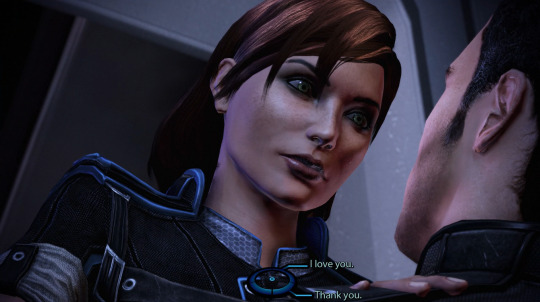
I didn't realize that FemShep's romance scene with Kaidan before going after The Illusive Man has more to it than MaleShep's does!

#MaleShepShouldGetToSayHeLovesKaidanToo #AndGetToSitOnHisLapForReasons 😇😉
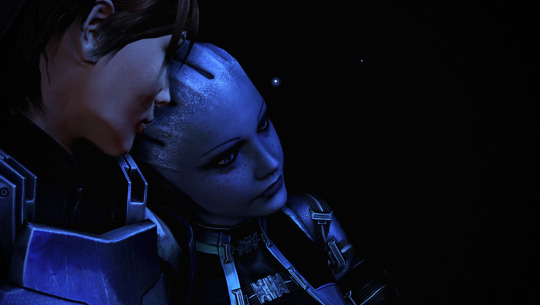
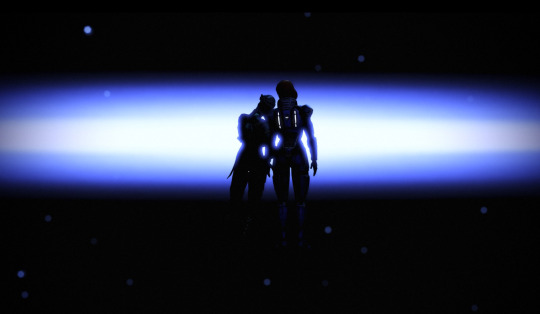
I know people often feel like Liara is constantly being forced in as Shepard's love interest, no matter who you're actually romancing, (and I'm not saying that's incorrect) but I honestly have such fondness for her that I don't mind. To me, Liara truly loves Shepard but while she shows it in ways like, you know, bringing her/him back from the dead, you also see it in little ways like this scene, where she's trying to give Shepard one last moment of peace before the final battle.
I always feel like Liara knew that this time, Shepard isn't coming back and there's no Cerberus or other magic in the entire galaxy strong enough to overcome that. This is it. This is Liara's last moment with the person she loves and I don't feel like she's over stepping any boundaries. She's not making a big declaration, she's not trying to kiss her or the like. She's just sharing this moment with her and I think that's very sweet. 💖

Anderson gives Shepard one last chance to rally her team, Liara, Garrus, Tali and, of course, Kaidan, who have been with her from the start. EDI who was there as an AI voice in ME2, then got her body in ME3 and James who's been with her from the start of ME3. But, of course, there's only one member who deserves the place of honor, right in the middle...
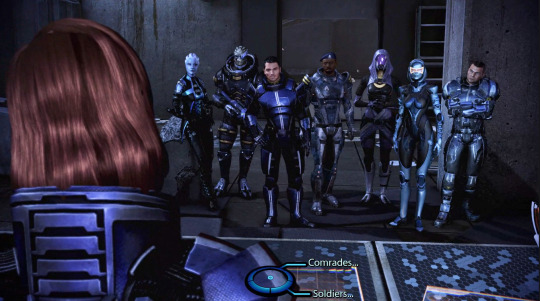
Sgt. Randall McRando.
Sooooooo, I, um, didn't go pick up Javik again. 😶 I MEANT to, I completely did, but I kept doing other missions first and then it was time to do the Shore Leave DLC and that felt like that would be super awkward to invite this guy they just literally met to a special party like that but would've been mean to exclude him so I just... Left him there. 😬He's fiiiiiine, though! At least it doesn't count him as dead like it'll do any of the ME2 squadmates if you don't visit them in 3. 😱
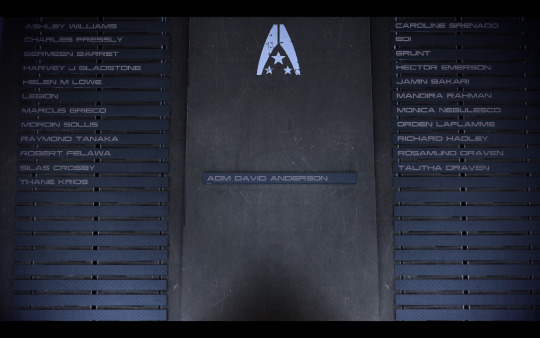
We never want to see Grunt's name on this wall ever again, m'kay? 😭
So without Javik, you get this random soldier standing in his place for some reason. Don't know why they couldn't have just left it empty?
Anyway, there were far worse repercussions. Or is that... Reaper-cussions?

Ahem. I'd checked my War Assets score and was well into the 7k but I forgot to check it one last time annnnnnd apparently I was just under the amount needed for the Destroy-but-Shep-takes-a-breath.


So Kaidan had to put our name on the wall because I got Shepard Super-Duper-Murder-Death-Killed! 😱😱😱
Which was not the ending I thought I'd get, yikes. And probably missing Javik was one of the reasons why my score came in just a bit too low. Oh well. I wanted my FemShep's first run to have at least a slightly hopeful ending but it is what it is.🤷♀️
Now I'll be heading back to ME1 yet again, this time with Shep hanging up her Infiltrator class (I enjoyed it) and trying out Engineer. We'll also be, ahem, trying out Garrus.

D'aww, Gare-bear! (Yes, I have completely 100% unironically blurted that out a few times. The first time was when he nearly got killed in his ME2 loyalty mission in my first playthrough. I legit gasped out, "Noooooo, Gare-bear!" 😱😭😂)
So that's my plan. Then we'll wrap things up with a Soldier FemShep and Liara romance. Annnnnd have an Absolute Cursed No-Import Playthrough of ME3 with MaleShep so I can romance Ashley without having had to choose to let Kaidan die in ME1. Since I already have done the Control ending among my preferred Destroy, I think for that playthrough I'll try Synthesis just so I can see it for myself. Then I'm still hoping to at least start Andromeda in June since my playthrough of it was in June, 2024. 😬
So I've got a lot more ME fun still to come! I actually did recently fit in a shorter game from my backlog but this post is already getting quite lorge so we'll talk about that another time. 😉
Love you all, friends, and I hope you're doing great! 🤗💖
#mass effect#mass effect 3#commander shepard#kaidan alenko#shenko#mshenko#liara t'soni#garrus vakarian#meet my new oc lol!#sgt randall mcrando#lol#ais plays mass effect#this is my game tag#ageless aislynn
12 notes
·
View notes
Text

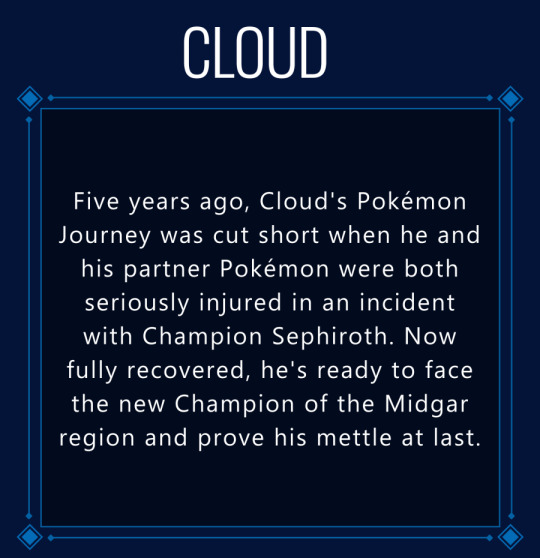
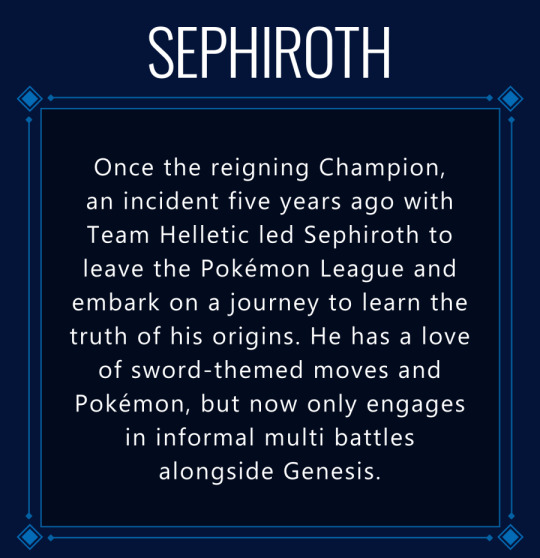
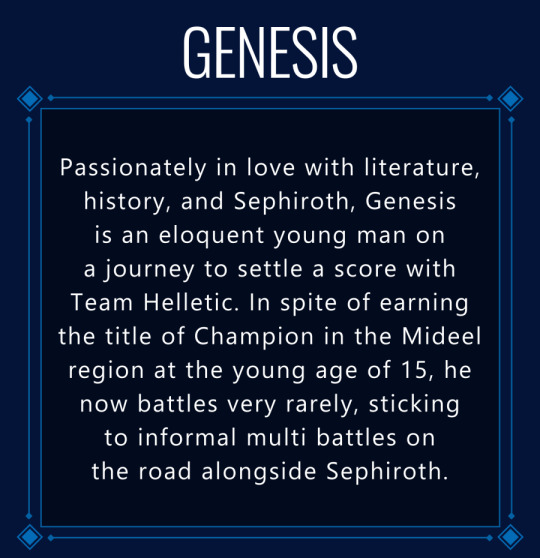
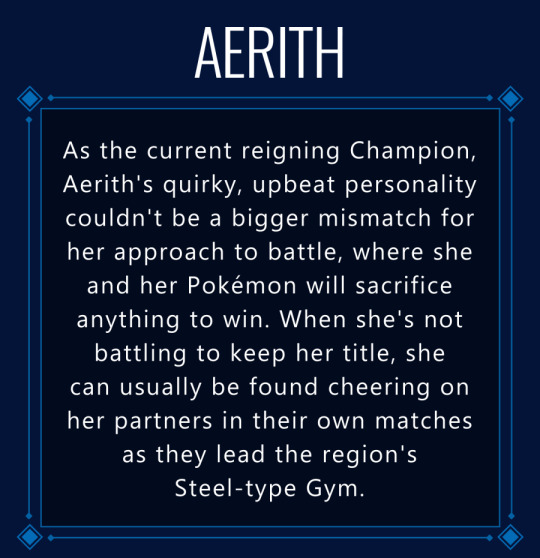
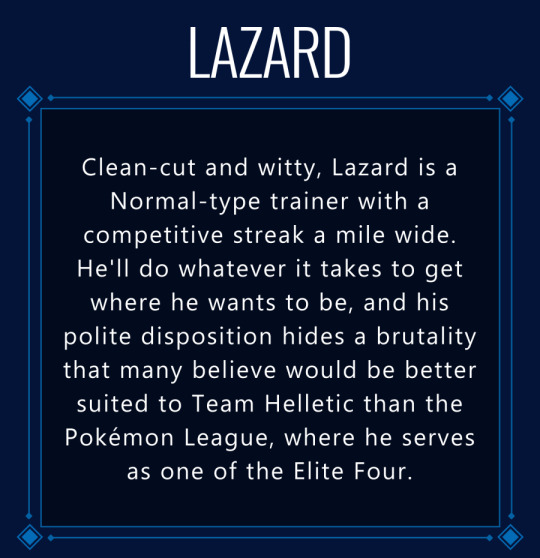
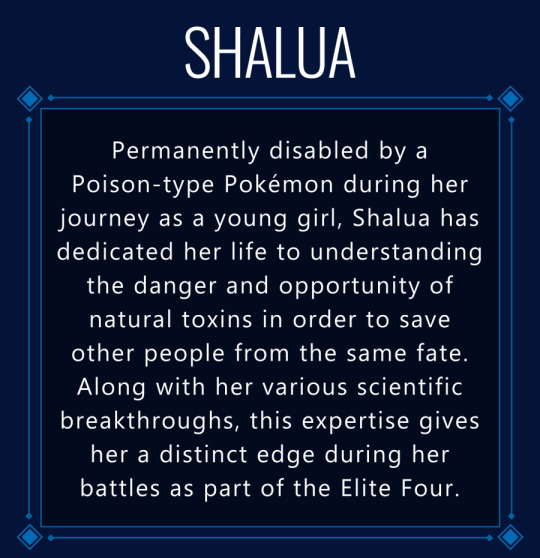
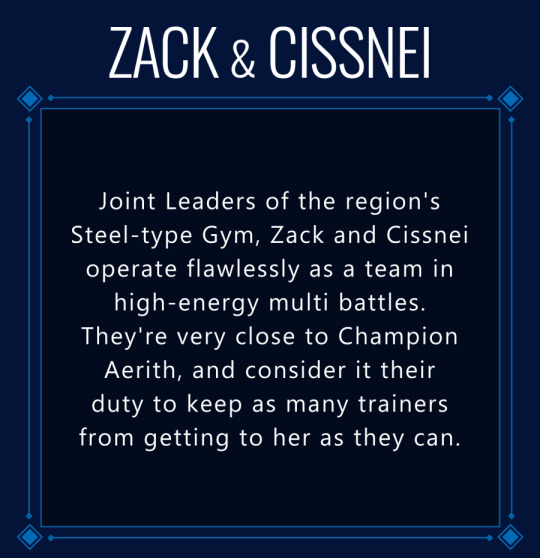
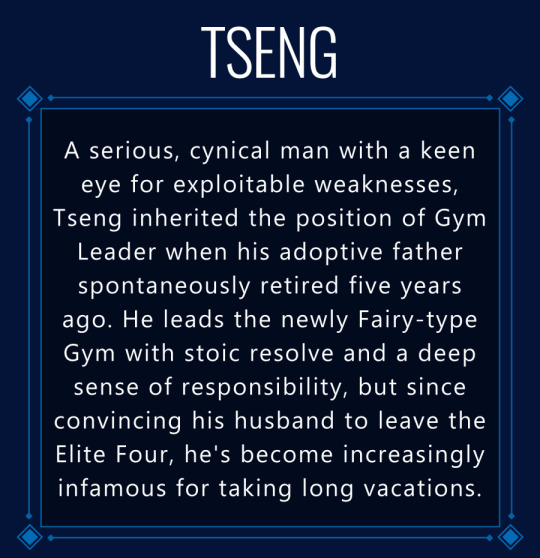
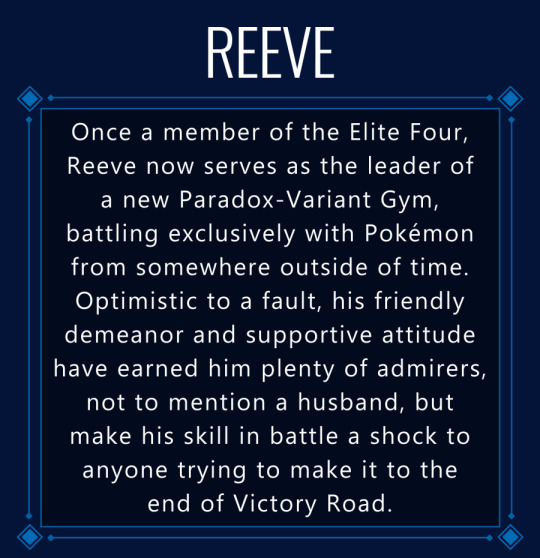
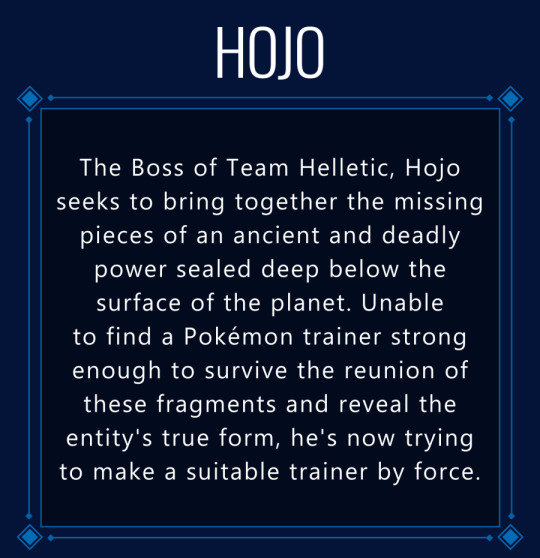
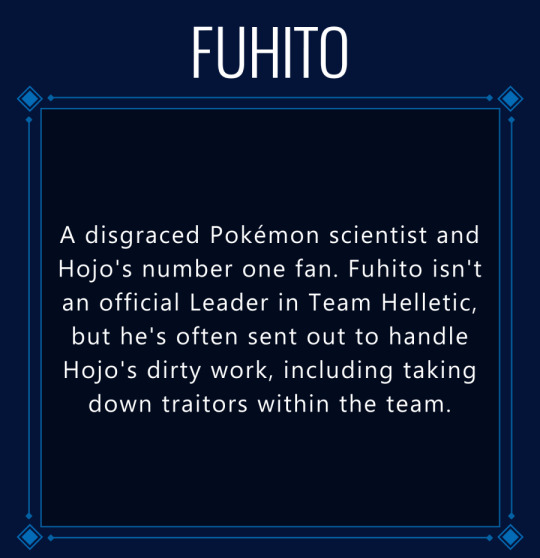
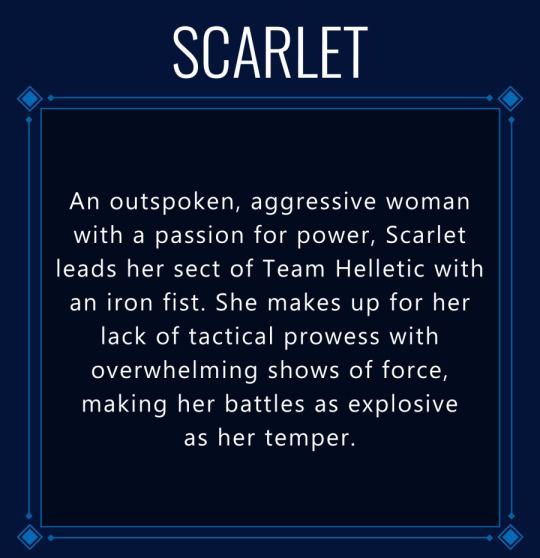
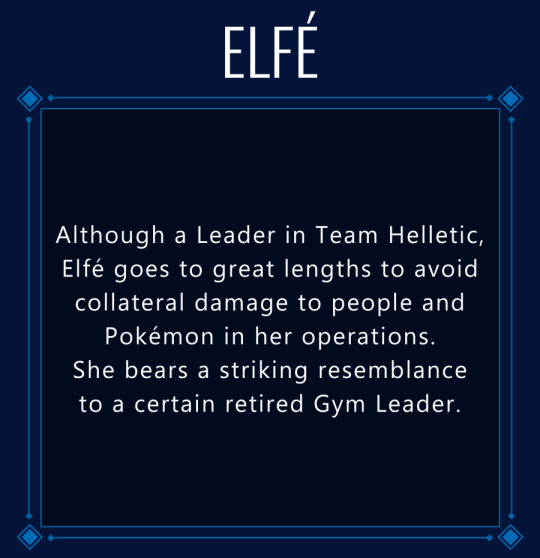

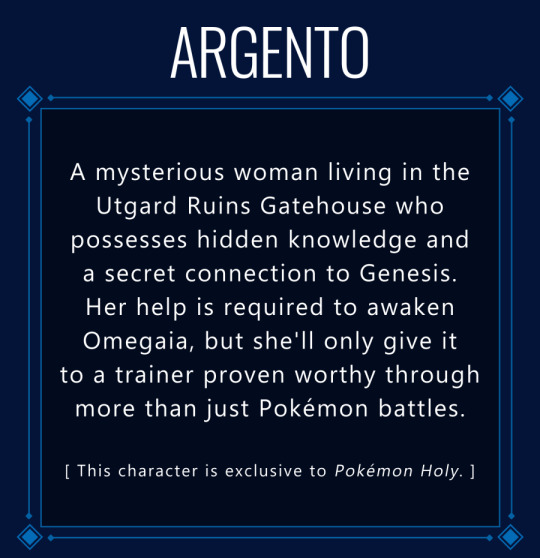
More Pokémon Holy/Meteor stuff. Nero's little profile isn't here because I have a whole picture of him on the same vein as Vincent's that I'd like to finish eventually. I am missing a handful of characters that would be in the "game," most notably the title's Professor (for which I am still torn between two options and may never settle) as well as Grimoire and Veld, who are both in the story but not technically integral to the main storyline(s).
There's a lot more than this bouncing around in my head but it's a lot so I'll stop with these and the notes below unless people are interested in something specific not covered here. (If so, drop me an ask and I'll happily answer! I love talking about my needlessly complicated crossover AUs, but they are so needlessly complicated that I don't generally just infodump about them.)
Other notes under the cut!
Cloud is the player character; the starting age for a Pokémon Journey in the Midgar region is 14, and he was 16 at the time of the accident, making him 21 during the main story. The storyline reflects this, as Cloud is much older than a standard protag for this series, but he's been out of the world recovering for long enough that he's still got a unique sort of naïveté. (Tifa would probably be the female protag but Cloud is the default here sorry.)
Sephiroth is the main "rival" in Pokémon Meteor, Genesis is the "rival" in Pokémon Holy, although they both appear in both titles and serve the same overall function for the narrative. They are not antagonists.
The Legendary for Meteor is "Jenosynthe," a reference to Jenova Synthesis; Holy has "Omegaia," which is a reference to Omega and to Gaia/Minerva. They have particular connections to Sephiroth and Genesis respectively, and Grimoire's contribution to the plot allows the player to obtain the other title's Legendary post-game.
The Midgar region is the only one to have "Variant" gyms, which focus on regional variants rather than a specific type. This is a new, secondary path with badges that can be mixed and matched with standard type-based gyms to reach the required number of badges to take on the League.
Other gym leaders: Kunsel (Psychic, he battles blindfolded), Reno and Rude (Electric), Yuffie (Hisuian variant), Rosso (Fighting*), Sonon (undecided on his gym but he's here), Weiss (Ground, because I love a stupid reference), and Chadley (secret unlockable Shiny variant gym, only accessible if you beat all the other gyms on both paths, bestows the Shiny charm), as well as others. *Veld's gym used to be Fighting-type but Tseng converted it when he took over following Veld's retirement, allowing Rosso to move out of her previous position with the League and set up a new one.
Other members of Team Helletic: Azul, Rayleigh, Gillian and Angeal (the "multi-generational multi-battle"), Sebastian and Essai (who are under the control of Something), and Shears, as well as others. Hollander was a member until the incident five years ago, which is implied to have led to his death.
Other important NPCs: Cid (the fast travel guy, may work with the Professor), Barret (runs the Pokémon breeding center), Cait Sith (a navi system that shows up through a specific set of sidequests and is revealed to be Reeve's at the end), Shelke (appears in the same sidequests as Cait Sith), Dio (runs a facility for fast EV training), and Johnny (nobody knows why he's here but he sure is), as well as others.
#pokemon holy/meteor#headcanon warning#pokemon crossover#final fantasy VII#FFVII#final fantasy 7#FF7#before crisis#crisis core#dirge of cerberus#the gang's all here!
49 notes
·
View notes
Text
in my first pass at a post destroy fic over a year ago i had played around with the whole starkid sequence being an indoctrination-induced hallucination. in truth i find the whole ending kind of... silly....... and i leaned into the indoctrination theory. ro had to not only figure out she was being tricked and resist the control/synthesis options presented to her and see them for what they were, but also the psychological manipulation starkid levied against her when it saw that it was losing its influence over her. changing its form from the child she watched die months ago to something that might have more weight behind it. give her a bigger dose of guilt and uncertainty. her loved ones, legion, edi, etc.
of course that's been through a lot of revision since then and nowadays i think that the choice is an important part of it. the whole manipulation tactic was too on the nose. if there never was a choice, and the geth and edi were simply doomed from the start, and it was always out of her hands, what guilt would she have to feel? she would feel bad, sure, but it's really not her fault. and that's boring. i want the destroy ending and all its consequences - killing a dear friend, wiping out a whole race of sentient beings - to be something she chose because it was the only option that made sense to her. and i want that to fucking haunt her for the rest of her days. maybe it WAS a hallucination, maybe there WAS manipulation - i think i can still include those elements but keep it vague. this is what she thought was happening, but was it really? she was already half-dead experiencing all of that. and she can play it back in her head every night, pick it apart, try to determine if and where she went wrong, where the proof of the holographic child being a bad actor was, and come up short every time. the physical and mental disability caused by her cybernetics failing is just the cherry on top. there's a lot of suffering in this ending, not that the suffering is the point. ultimately the story i want to tell is her overcoming what she can and making peace with the rest, and it still is the only ending that guarantees an end to the reaper threat, once and for all, which i think will always be her ultimate goal that informs every choice she makes. there's just a lot of delicious angst potential that i like
18 notes
·
View notes
Text
Physics Friday #5: The Wonderful World of Programming Paradigms
Welcome to the first actual post on the dedicated blog! This will be continuing on from what I started over on my main account @oliviax727. But don't worry, I'll still repost this post over there.
Preamble: Wait! I thought this was Physics!
Education level: Primary School (Y5/6)
Topic: Computer Languages (Comp Sci)
So you may be thinking how this is relevant to physics, well it's not. But really, other adjacent fields: computer science, chemistry, science history, mathematics etc. Are really important to physics! The skills inform and help physicists make informed decisions on how to analyse theoretical frameworks, or to how physics can help inform other sciences.
I may do a bigger picture post relating to each science or the ways in which we marry different subjects to eachother, but what is important is that some knowledge of computer science is important when learning physics, or that you're bound to learn some CS along the way.
Also I can do what I want, bitch.
Introduction: What is a Programming Language?
You may have come across the term 'programming paradigm' - especially in computer science/software engineering classes. But what is a programming paradigm really?
Computers are very powerful things, and they can do quite a lot. Computers are also really dumb. They can't do anything unless if we tell them what to do.
So until our Sky-net machine overlords take control and start time-travelling to the past, we need to come up with ways to tell them how to do things.
Pure computer speak is in electrical signals corresponding to on and off. Whereas human speak is full of sounds and text.
It is possible for either one to understand the other (humans can pump electrical signals into a device and computers can language model). But we clearly need something better.
This is where a programming language comes in. It's basically a language that both the computer and the human understands. So we need a common language to talk to them.
It's like having two people. One speaks Mandarin, the other speaks English. So instead of making one person learn the other's language, we create a common language that the two of them can speak. This common language is a synthesis of both base languages.
But once we have an idea of how to communicate with the computer, we need to consider how we're going to talk to it:
How are we going to tell it to do things?
What are we going to ask it to do?
How will we organise and structure our common language?
This is where a programming paradigm comes in - a paradigm is a set of ideas surrounding how we should communicate with a device. It's really something that can truly only be understood by showing examples of paradigms.
Imperative vs. Declarative
The main two paradigms, or really categories of paradigms, are the imperative vs. declarative paradigm.
Imperative programming languages are quite simple: code is simply a set of instructions meant to tell the computer specifically what to do. It is about process, a series of steps the computer can follow to get some result.
Declarative programming languages are a bit more vapid: code is about getting what you want. It's less about how you get there and more about what you want at the end.
As you can see imperative programs tell the computer how to do something whereas declarative programs are about what you want out.
Here's an example of how an imperative language may find a specific name in a table of company data:
GET tableOfEmployees; GET nameToFind SET i = 0; WHILE i < tableOfEmployees.length: IF tableOfEmployees[i].firstName == nameToFind THEN: RETURN tableOfEmployees[i] AND i; ELSE: i = i + 1; RETURN "employee does not exist";
And here's that same attempt but in a declarative language:
FROM tableOfEmployees SELECT * WHERE firstName == INPUT(1);
Note that these languages aren't necessarily real languages, just based on real-life ones. Also please ignore the fact I used arrays of structures and databases in exactly the same way.
We can see the difference between the two paradigms a lot more clearly now. In the imperative paradigm, every step is laid out clear as day. "Add one to this number, check if this number is equal to that one".
Under the declarative paradigm, not only is the text shorter, we also put all of the instructions about how to do a task under the rug, we only care about what we want.
With all this, we can see an emerging spectrum of computer paradigms. From languages that are more computer-like, to languages that are more English-like. This is the programming languages' level:
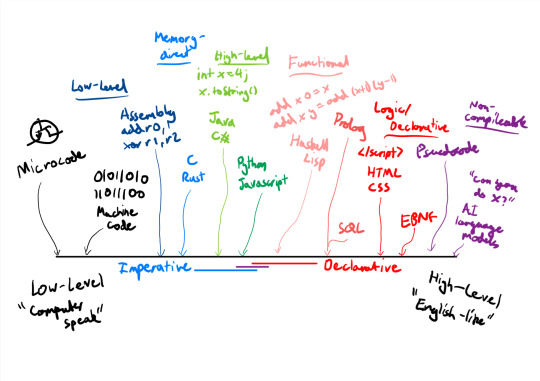
Lower level languages are more likely to be imperative, as the fundamental construction of the computer relies on a series of instructions to be executed in order.
The lowest level, the series of electrical signals and circuitry called microcode is purely imperative in a sense, as everything is an instruction. Nothing is abstracted and everything is reduced to it's individual components.
The highest level, is effectively English. It's nothing but "I want this", "I'd like that". All of the processes involved are abstracted in favour of just the goal. It is all declarative.
In the middle we have most programming languages, what's known as the "high level languages". They are the best balance of abstraction of reduction, based on what you need to use the language for.
It's important that we also notice that increasingly higher-level and increasingly more declarative the language gets, the more specific the purpose of the language becomes.
Microcode and machine code can be used for effectively any purpose, they are the jack-of-all trades. Whereas something like SQL is really good at databases, but I wouldn't use it for game design.
As long as a language is Turing-complete, it can do anything any computer can do, what's important is how easy it is to program the diverse range of use-cases. Assembly can do literally anything, but it's an effort to program. Python can do the same, but it's an effort to run.
Imperative Paradigms: From the Transistor to the Website
As mentioned previously, the imperative paradigm is less a stand-alone paradigm but a group of paradigms. Much like how the UK is a country, but is also a collection of countries.
There are many ways in order to design imperative languages, for example, a simple imperative language from the 80's may look a lot like assembly:
... ADD r1, 1011 JMZ F313, r1
The last statement JMZ, corresponds to a "Jump to the instruction located at A if the value located at B is equal to zero" what it's effectively saying is a "Repeat step 4" or "Go to question 5" type of thing.
Also known as goto statements, these things are incredibly practical for computers, because all it requires is moving some electrical signals around the Registers/RAM.
But what goto statement is used as in code, is really just a glorified "if x then y". Additionally, these statements get really irritating when you want to repeat or recurse over instructions multiple times.
The Structured Paradigm
Thus we introduce the structured paradigm, which simply allows for control structures. A control structure is something that, controls the flow of the programs' instructions.
Control structures come in many forms:
Conditionals (If X then do Y otherwise do Z)
Multi-selects (If X1 then do Y1, if X2 then do Y2 ...)
Post-checked loops (Do X until Y happens)
Pre-checked loops (While Y, do X)
Counted Loops (For i = A to B do X)
Mapped Loops (For each X in Y, do Z)
These control structures are extra useful, as they have the added benefit of not having to specify what line you have to jump to every time you update previous instructions. They may also include more "safe" structures like the counted or mapped loop, which only executes a set amount of time.
But we still have an issue: all our code is stuffed into one file and it's everywhere, we have no way to seperate instructions into their own little components that we might want to execute multiple times. Currently, out only solution is to either nest things in far too many statements or use goto statements.
The Procedural Paradigm
What helps is the use of a procedure. Procedures are little blocks of code that can be called as many times as needed. They can often take many other names: commands, functions, processes, branches, methods, routines, subroutines, etc.
Procedures help to organise code for both repeated use and also it makes it easier to read. We can set an operating standard of "one task per subroutine" to help compartmentalise code.
Object-Oriented Code
Most of these basic programming languages, especially the more basic ones, include the use of data structures. Blocks of information that holds multiple types of information:
STRUCT Person: Name: String Age: Integer Phone: String Gender: String IsAlive: Boolean
But these structures often feel a bit empty. After all, we may want to have a specific process associated uniquely with that person.
We want to compartmentalise certain procedures and intrinsically tie them to an associated structure, preventing their use from other areas of the code.
Like "ChangeGender" is something we might not want to apply to something that doesn't have a gender, like a table.
We may also want to have structures that are similar to 'Person' but have a few extra properties like "Adult" may have a bank account or something.
What we're thinking of doing is constructing an object, a collection of BOTH attributes (variables) AND methods (procedures) associated with the object. We can also create new objects which inherit the properties of others.
Object oriented programming has been the industry standard for decades now, and it's incredibly clear as to why - it's rather useful! But as time marches forward, we've seen the popularisation of a new paradigm worthy of rivaling this one ...
Declarative Paradigms: The World of Logic
Declarative languages certainly help abstract a lot of information, but that's not always the case, sometimes the most well known declarative languages are very similar feature-wise to imperative paradigms. It's just a slight difference in focus which is important.
Functional Programming Languages
Whereas the object oriented language treats everything, or most things, like objects. A functional language uses functions as it's fundamental building block.
Functional languages rely on the operation of, well, functions. But functions of a specific kind - pure functions. A pure function is simply something that doesn't affect other parts of the computer outside of specifically itself.
A pure function is effectively read-only in it's operation - strictly read-only. The most practical-for-common-use functional languages often allow for a mixture of pure and impure functions.
A functional language is declarative because of the nature of a function - the process of how things work are abstracted away for a simple input -> output model. And with functional purity, you don't have to worry about if what takes the input to the output also affects other things on the computer.
Functional languages have been around for quite a while, however they've been relegated to the world of academia. Languages like Haskell and Lisp are, like most declarative languages, very restrictive in their general application. However in recent years, the use of functional programming has come quite common.
I may make a more opinionated piece in the future on the merits of combining both functional and object-oriented languages, and also a seperate my opinions on a particular functional language Haskell - which I have some contentions with.
Facts and Logic
The logic paradigm is another special mention of declarative languages, they focus on setting a series of facts (i.e. true statements):
[Billy] is a [Person]
Rules (i.e. true statements with generality):
If [A] is [Person] then [A] has a [Brain]
And Queries:
Does [Billy] have a [Brain]?
Logical languages have a lot more of a specific purpose, meant for, well, deductive/abductive logical modelling.
We can also use what's known as Fuzzy logic which is even more higher-level, relying on logic that is inductive or probabilistic, i.e. conclusions don't necessarily follow from the statements.
Visual and Documentation Languages
At some point, we start getting so high level, that the very components of the language start turning into something else.
You may have used a visual language before, for example, Scratch. Scratch is a declarative language that abstracts away instructions in-favour of visual blocks that represent certain tasks a computer can carry out.
Documentation languages like HTML, Markdown, CSS, XML, YML, etc. Are languages that can barely even be considered programming languages. Instead, they are methods of editing documents and storing text-based data.
Languages that don't even compile (without any significant effort)
At some point, we reach a point where languages don't even compile necessarily.
A metalanguage, is a language that describes language. Like EBNF, which is meant to describe the syntaxing and lexical structures of lower-level languages. Metalanguages can actually compile, and are often used in code editors for grammar checking.
Pseudocode can often be described as either imperative or declarative, focused on emulating programs in words. What you saw in previous sections are pseudocode.
Diagrams fall in this category too, as they describe the operation of a computer program without actually being used to run a computer.
Eventually we reach the point where what were doing is effectively giving instructions or requesting things in English. For this, we require AI modelling for a computer to even begin to interpret what we want it to interpret.
Esoteric Paradigms
Some paradigms happen to not really fall in this range form low to high level. Because they either don't apply to digital computing or exist in the purely theoretical realm.
Languages at the boundaries of the scale can fall into these classes, as microcode isn't really a language if it's all physical. And pseudocode isn't really a language if it doesn't even compile.
There are also the real theoretical models like automata and Turing machine code, which corresponds to simplified, idealised, and hypothetical machines that operate in ways analogous to computers.
Shells and commands also exist in this weird zone. Languages like bash, zsh, or powershell which operate as a set of command instructions you feed the computer to do specific things. They exist in the region blurred between imperative and declarative at the dead centre of the scale. But often their purpose is more used as a means to control a computer's operating system than anything else.
Lastly, we have the languages which don't fit in our neat diagram because they don't use digital computers in a traditional manner. These languages often take hold of the frontiers of computation:
Parallel Computing
Analog Computing
Quantum Computing
Mechanical Computing
Conclusion
In summary, there's a lot of different ways you can talk to computers! A very diverse range of paradigms and levels that operate in their own unique ways. Of course, I only covered the main paradigms, the ones most programmers are experienced in. And I barely scratched the surface of even the most popular paradigms.
Regardless, this write-up was long as well. I really wish I could find a way to shorten these posts without removing information I want to include. I guess that just comes with time. This is the first computer science based topic. Of course, like any programmer, I have strong opinions over the benefits of certain paradigms and languages. So hopefully I didn't let opinions get in the way of explanations.
Feedback is absolutely appreciated! And please, if you like what you see, consider following either @oliviabutsmart or @oliviax727!
Next week, I'll finish off our three-part series on dark matter and dark energy with a discussion of what dark energy does, and what we think it is made of!
53 notes
·
View notes
Text
Predicting Mat and Tuon's Character Growth
Mat’s character development is temporarily plateaued along with Tuon’s at the end of AMOL, because they have been developing together since book 9, and have more developing to do together/catalyzed by each other post-series.
Mat‘s arc is about not just accepting responsibility reflexively, but doing it willingly and strategically. To fully grow as a person, Mat needs to move through abandonment of responsibility, through avoiding responsibility, through reactive, passive responsibility, and finally to proactive agency.
Tuon's arc should be about not just delegating control, but giving up control willingly and strategically. To fully grow as a person, Tuon needs to move through obsessive, self-defensive control, through reactive, passive control, through abandonment of control, and finally to responsible, appropriate control.
Tuon’s role in Mat's development is to push him to not just stop running from responsibility (a thing he has already mostly stopped doing) but to actively choose responsibility & thus gain a measure of control over his life and actions. Reactive responsibility- diving into crisis situations without thinking- is only getting him so far, and by the time Tuon shows up I think he's kind of desperate for a strategic change.
(This is long, so the following sections are under the cut:
Mat's First Shift to Proactive Agency
Why Mat is Tuon's Catalyst
How Tuon Can Help Mat Grow
Mat's Second Shift to Proactive Agency
How Mat Can Help Tuon Grow)
Mat's First Shift to Proactive Agency
Choosing to kidnap Tuon after she is revealed to be the Daughter of the Nine Moons and his fated wife, and therefore choosing to actively pursue his fate, is a huge turning point for Mat. It is an echo and synthesis of both the last time he made a decision to steal something valuable and dangerous for his own gain (the Shadar Logoth dagger) and the last time he actively searched for guidance (going to the Aelfinn to ask what he should do now that his internal compass- his memories- are gone.) In choosing to take Tuon with him, Mat is marrying (pun aggressively intended) his impulsive curiosity & pursuit of self-interest to his desperate desire for direction and purpose.
We know Mat loves to be needed. He eats that shit up. He craves respect so intensely because it’s the thing he didn’t have growing up, and he’s also in partial denial about that being what he wants, because he’s a lying liar who lies to himself more than anyone else.
He takes on the hero role because he can’t not- his values demand it and Mat defines himself by his values because they are literally all he had at one point- but it’s also a thing he does to get what he craves, which is respect and attention. (Any attention will do in a pinch, but positive attention is best.) That’s the part of him that gets super shirty about not being thanked/acknowledged. Being reactively heroic is a compulsion for him, but by around book 7 he's realized it's not getting him what he really wants, which is respect and (self-defined) success. He doesn't really have another plan though, until he willingly steps into his dire fate by kidnapping Tuon.
Over the course of the series, Tuon continues to push Mat to actively take responsibility and accept the consequences. The promise he makes to get her home safely turns into his education in the personal uses (and abuses) of power. She is the catalyst that makes him use his personal army in physical warfare for his own purposes. Before he’s used it as a facet of Rand’s army at Rand’s direction, and when he did use it for his own purposes, it was lending it to Egwene for psychological warfare only.
This education in power is why Tuon approves of his war crimes even though she fully admits they are brutal and committed against her own people; they show he understands that his actions as a leader can have horrible consequences, and also that he can prioritize the mission at hand. She says she's just waiting for him to prove he's the person from the prophecy, but she's also clearly testing him to see if he can handle the power she'd be delegating to him, by seeing how he handles the power he currently possesses in his own right.
Why Mat is Tuon's Catalyst
Tuon is very hard to impress, but Mat impresses her- and he impresses her the most when he’s not trying to be impressive, when he’s just being authentic and pursuing his self-interest. She's not just interested in his military competence, although that's certainly interesting to her- she's also interested in his political acumen and ability to deescalate or escalate situations as needed. His ability to fit in everywhere and command a situation- especially when she thought he was losing- like when she collars Joline, or when he scraps his winning streak in the hell- is so compelling to her.
On one level she's no stranger to winning from a position of weakness, given that her default M.O. is apparently 'play dead'. But I don't think Tuon has fit in anywhere without a great deal of effort, and Mat's sprezzatura is a pretty different strategy from her disappearing acts or virtuoso compulsion tactics. I'm not even thinking so much about Tuon's constant fending off of assassination attempts; more along the lines that we know she had to train herself to have Resting Bitch Face and project 6 feet of presence from 4'11".
(Incidentally, I don't know if she knows the Crystal Throne is a mind control ter'angreal, especially since she seems to be canonically resistant to mind control, so it's possible she's been assuming her mom's magically-augmented strength of presence is natural. No wonder she feels inadequate.) She's also clearly incredibly weird to both normal Seanchan and other people in her social sphere, whereas Mat is a social chameleon coasting on instinct (and thousands of strategic geniuses).
Tuon is desperately envious of and fascinated by authentic people who pursue their own self-interest, since she can't pursue her own self-interest without cloaking it as her duty, and she can't be an authentic person except by either flying under the radar or using up social capital by being stubborn. Her life is circumscribed by so many forces outside her direct control, yet she believes she is supposed to control everything for her own survival and the good of the world.
Mat seems to be to Tuon what she longs to be- a responsible, independent, kind leader who forges their own path in response to changing conditions & who has earned the respect, loyalty, and competence of their followers. She’s completely baffled at how Mat got there from being... Mat... but she recognizes that it gets results. I think the end result of her development is ideally to become more like Mat- someone who is a person first, albeit one with an outsized sense of responsibility, who is able to act productively on her instincts to help people.
How Tuon Can Help Mat Grow
Meanwhile, Tuon is someone whose strengths, struggles, and shared values Mat can learn from. Like him, she's been brainwashed by a paranoid culture where the ends justify the means, and unlike him, she spent almost her entire life in it. Yet she still has a powerful sense of empathy, even if it's twisted in the service of the Empire and she mostly uses it for manipulating people. It's clear that what she thinks will help people most is her control rather than her empathy, so that's what she tries hardest to give. But the empathy seeps out even when it isn't deliberately being used to build power or influence, like when she caught that Jain was feeling guilty about leaving his wife to die. Mat should follow Tuon at her best, and not completely strangle his sympathetic impulses in the service of power.
(A note on terms: Mat's sympathetic- he's always putting himself in other people's shoes and imagining how he would feel in their situation, and that motivates him to action on their behalf. It's about saving himself in the shape of the other. Tuon's empathetic- she can imagine how someone else feels and mirror their feelings back, or manipulate them based on her accurate assessment of their feelings. It's about modeling her social/political environment and therefore exerting the correct amount of control for the reaction she wants.)
Tuon's also built and sustained a culture of personal loyalty- one of her and Mat's shared values- in an utterly paranoid environment. The degree to which her personal slaves care about her is unusual for imperial Seanchan- it was very surprising that Selucia wanted to stay with her, and notably unusual for Karede to request to work with her again. The loyalty her personal damane show her is largely due to her skill at manipulation and brainwashing rather than anything resembling charisma or personal virtues- the damane have vastly less choice about who owns them or commands them than Selucia or Karede do- but she seems to be less openly cruel to damane and da'covale than say, Suroth. (Yes, I know, the bar here is in the ocean.) She also has Setalle Anan of all people willing to protect her, and while Setalle has an agenda and isn't doing it just because she likes Tuon, I think Setalle does actually like her. Mat should also be making friends and allies in his enemies' stronghold.
Finally, Tuon's weirdly open to other people's input and correction, for someone in her position and with her background. Again, the bar is so low as to be at the bottom of the Aryth Ocean, but she did apologize for 'giving an order in anger', which is to say throwing a temper tantrum, which is to say abusing her power beyond acceptable-to-her limits. The limits she accepts on her power and agency are more stringent than what would be acceptable to her peers or advisors in her position. Related to this sense of integrity, she's very stubborn around anything directly involving either her survival or her responsibilities to others. And because she's spent so much time building her personal integrity and being open to criticism from trusted advisors, she's very comfortable with having and using power, at least in terms of judgement and delegation (her own Power is, uh, the major exception.)
Mat, on the other hand, starts out the series very uncomfortable with power- and that's good in some ways- but people with power who aren't comfortable with power are like people who carry weapons they don't know how to use. Those weapons are just going to be used against them. His time with Tuon is there to give him practice intentionally wielding power.
Mat's Second Shift to Proactive Agency
One thing that I think Tuon still has to teach him, though, is the strategic value of lying low, keeping intentions secret, and quietly building a power base in pursuit of a long-term goal. Mat's great at dramatic, impulsive, risky gambles; not so great at staying still and waiting for the right moment in an intentional way. He always wants to be DOING something, immediately. But just thrashing out reflexively is not going to work for taking on the Seanchan, as Rand found out. Mat gets a taste of the kind of strategic timing he needs, when working with Tuon to trick everyone into thinking the Seanchan are out of the fight, then having her come back in with the army at a critical juncture.
I'm convinced that Mat's path to full character development will be to fully accept his power base in the Seanchan military/political machine... and destroy it from the inside out, either intentionally or as acceptable collateral damage in saving Tuon from herself.
Even Tuon can tell that structurally, he's got 'military coup' written all over him. She just doesn't believe he would ever do it because she knows he's loyal to her, and ever since becoming Empress she can't conceive of a situation where "Tuon" and "the Seanchan Empire" are separated that doesn't mean her own death. She has a blind spot in the exact place where Mat is most creative and motivated: preventing Tuon-the-person from dying (physically or spiritually) when the Empire does.
There's all sorts of interesting strategic gambles Mat can take advantage of. The Empire has cracks all over the place. The continent of Seanchan is a hot mess of civil war and domestic infighting and that's going to prevent Tuon from using it as a power base immediately, and distract her from local issues. The sul'dam secret and Tuon's relationship to it is already out among her most dangerous enemies (her immediate peers) and Elayne's gambit to rehabilitate sul'dam and damane and send them back to Seanchan territory is also going to spread that info.
Tuon and Mat's kids are a ticking time bomb of 'likely to be involuntary channelers' and even before that, you think Mat's going to do nothing to mitigate the childhood trauma of 'everyone is trying to kill me'? This man raised an orphan in a war camp in a perpetual 'take your adopted child to work day'. He might not be able to get them out of the Seanchan cultural deathtrap altogether, but he's going to do his best to make it less dangerous for them, which could mean radical cultural change.
Oh, and the Aiel are going to want their Wise Ones back in the next year and a day, which has the potential to be a real diplomatic time bomb. Also, as far as I can tell, no one has yet told the Black Tower they can't make war on the Seanchan, who will be in a tight spot re: getting more female damane, and therefore very interested in anything they can do with male channelers, ESPECIALLY if they can be convinced saidin is clean. Also: Moghedien is there!?! And Elaida, for that matter. Creator help anyone who goes to Elaida for Foretellings.
Seanchan has 99 problems and I guarantee you Tuon is thinking that at least her man ain't one. She is wrong. She is so, so wrong. (And we haven't even gotten to Min, who could convince Tuon to do pretty much anything if she played her cards right, because Tuon is weak to prophecy and trusted advisors. Or Mat's private army, which is going to be both a point of political tension and a valuable asset for him.)
How Mat Can Help Tuon Grow
I don't think people who think that Mat has utterly surrendered and lost his moral compass by falling in (love) with Tuon are correct. Mat has a history of losing to win. And I think Tuon is going to teach him- by example and circumstance- how to take responsibility in the most deliberate possible way, for the biggest possible stakes. She's going to teach him how to win friends and influence people in his new environment. She's going to teach him how to wait for precisely the right moment for maximum impact. And she's going to teach him how to sneakily rescue the fuck out of an entire society or die trying.
But Tuon can't learn that she's a person, not an institution, until she's literally removed from the institution and it is removed from her. When it comes to damane and slavery more broadly, she IS the Empire, and her changing her heart and mind- even if it were possible for that to come first- does jack shit to actually help anyone enslaved by Seanchan without the material conditions for societal change.
Empires change by economic, military, social pressures combined. You have to break the Empire before you can break Tuon, at least if you're Mat and you like her, and also if you want her along to help you pick up the pieces and fit them into something that doesn't just kill everyone and create more massive collateral damage. Tuon's relationship with power is cancerous; her desire for control has metastasized through her life and the lives of others, and the entry point of that relationship is her self-image as The Empress (and before that, a sul'dam, and an imperial heir...)
Mat's the mature one here, for a change, and that means his character development has to come first; Tuon's will fall into place once you change the conditions around her. She's infinitely malleable that way, because she was shaped to be responsive to those pressures from birth, and she kept shaping herself to be responsive to them as a survival tactic.
Mat listens to his instincts and the dice in his head because he relies on them for survival; Tuon looks for the omens in the world and the shifting currents of power because she relies on them for survival. Once Tuon experiences the consequences of her overreach, if Mat builds Tuon a world where she and others can survive without slavery and exploitation, where she doesn't HAVE to have an iron grip on everything, I promise you she'll go for it. Above everything else, Tuon is a survivor, and I think she could surprise you by how much she would change to survive.
#wheel of time#wot meta#wheel of time meta#wot book spoilers#a memory of light spoilers#mat/tuon#problematic fave tuon#oh look it's another multi-page essay no one asked for#tl;dr: Tuon will accidentally teach Mat how to military coup her and then she'll experience Consequences and Therapy in that order
70 notes
·
View notes
Note
Totally agree with everything.
You might have already said this or someone else about The DPS should be an Endgame event (which I agree with). I think Jean should become the Phoenix in movie 5 so you already have that investment of that Scott/Jean relationship and how the power of the phoenix affects it. Then do DOFP in movie 6 or 7. Introduce the Sentinels at the end of move 1 or 2 (Ahab, Trask, Shaw ect) for an better throughline into DOFP. Maybe Kitty and the white queen in movie 2 or 3 (for the hellfire plot in the DPS). Or it could be the first movie with Charlie and Emma fighting (not physical) of Kitty.
With DOFP, you can do Rachel in an Kitty flashback (a way to introduce Franklin Richards as well since Marvel is doling the FF). Or, this is my controversial part, do DOFP in two movies w/6 all in Earth-811 and 7/in Earth 616. Have Rachel as an Hound as Ahab’s favorite only at to befriend Kitty (as Kate) and place Kitty in the past at the end. That might be too dark for Marvel and Disney, but DOFP is dark, and I feel like it has to feel like an real timeline (hence its only Earth-881 b/c of Kitty's intervention) not just an plot point (I understand the sensitivity of what I’m taking about and I no way asking to be grim dark).
Then the next time we see Rachel is ringing the doorbell in end credit scene at the end of movie 10 (or something).
Change anything you like. Disagree. Just have fun. Thank you for reading.
BTW, looked up Rhea Ripley, hell yeah, she should be Rachel.
I agree about DPS being an Endgame-like event, because as I've said before, it's properly understood as the second half of a diptych with the Phoenix Saga. So if DPS is movie #5, that's fine - as long as the Phoenix Saga is movie #4. The key thing is that audiences have to experience Jean Grey as an unambiguous hero in the first film before they see her become a villain in the second film.
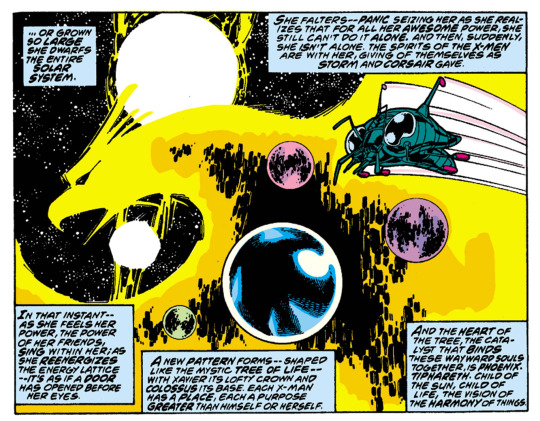
Likewise, it's important that audiences experience the Phoenix itself as a positive force in the first film so they don't get the wrong idea about what it is - looking at you, Avengers vs. X-Men and Jason Aaron more generally. The Phoenix is not evil or destructive by nature, nor is it destined to go out of control (see Rachel Summers) - it is Tiferet (or as Claremont spells it, Tiphareth), the synthesis of compassion and judgement. It only goes out of control when the psychic blocks that Jean, not Xavier, created to keep the power of the Phoenix within limits that a mortal could control are dismantled by Jason Wyndgarde as part of the Hellfire Club's machinations.
As for DOFP, I think you have to have present-616 and future-811 in the same movie, both for structure reasons (there are careful parallelisms between what's happening in one timeline and the next) and because otherwise 811 is too unrelentingly bleak: it's important to soften the blow of seeing the X-Men killed by Sentinels by showing them succeed in thwarting the Brotherhood. As for Rachel, I think you show her as an X-hound using her chrono-skimming to send Kitty back at the beginning of the movie, and then show her in the post-credits transporting between dimensions as a hope spot to counter-balance the downbeat of Senator Kelly getting the Sentinel program restarted.
I would leave the Hound stuff for traumatic flashbacks in the next film, so that DOFP is really Kitty's story and the next movie is Rachel's story.
14 notes
·
View notes
Text
Dance with the Chaos
August 10, 2014.
“The missing key to the exceptional—mind phenomenon is the undefined—what we ordinarily think of as chaos—and allow the unknown to disclose its own patterns and laws.” Life of the Mind. p. X
End of entry
My margin notes to above:
The gist of my close. 1/14/2015 re: the Mendosa Trial
Patterns.--- phenomena case themes.
(Referring to my closing argument to the jury after a 4 month gang murder trial in 2014-2015.)
Notes: 9/28/2024
Practicing criminal law is pretty much like surfing the tides of controled chaos.
In any criminal case, you have the conflicting and competing dynamics of a prosecutor and judge that want to push the case along in rapid fashion. You’ve got the client, who may be in custody, grappling with the twin desires of release from jail and fair case resolution. You, the attorney, are juggling a heavy case load.
And, if you are in jury trial, as I was in the Mendosa trial mentioned in the 2014 entry, you have all of these factors plus the pressure of trying to convince a jury to do the right thing.
So, I like the suggestion of the quote from the book “Life of the Mind” above. Quiet down and try to feel the patterns in the swirling chaos. Learn how to dance with the chaos.
A limber body and mind help. So away from court, I work out in the gym and I swim in the ocean. I journal, I read and I blog out the synthesis of the whole life experience. My writing is the way that it all speaks and may present it;s rhythm.
The above journal entry was included in a leather bound 2014-2015 journal. A photo of that journal is included in the following post.
I have been a criminal defense attorney for 43 years.
#journaling#journal#criminal defense#8/102014#dance with the chaos#find rhythms in the chaos through writing
6 notes
·
View notes
Text
Grinding Gear Games Live Stream for March 21, 2024
So I wasn't the biggest fan of the Adepticon live stream from last night. I'm hoping Grinding Gear Games can make up for that a bit with new details on Path of Exile 2 and Necropolis. While not the first time I've reacted to a League announcement (I think that was Synthesis?) this will be my first live reaction on this blog.
I absolutely love Path of Exile. When I was trying to do the YouTube thing, I tried my hand at making some PoE content. Unfortunately I hate editing, especially sound editing (does not go well with migraines). So that put an end to that. This is one of the reasons I've tried to move to a blog format, despite the fact that blogs get far less attention. But somehow, it never occurred to me to do blog posts about Path of Exile!
I might also try putting some content on here about Last Epoch, since I'm falling in love with that game as well. Don't know if it will replace PoE as my favorite ARPG, but it's definitely a ton of fun!
With that preamble out of the way, let's do some predictions!
Predictions
For Path of Exile 2, we know they're probably going to be giving us some Ranger gameplay. Johnathan has also talked about the Witch, but I'm gonna guess she's not ready based on things he said in a recent interview. So, for my prediction, I'm going to say we'll also finally see a reveal of one of the itemization systems.
As for Necropolis, that sounds so much like it would be a dungeon League. But we just had one, so I'm thinking this will mostly be a map mechanic. Judging from the preview, I'm betting we're going to have to dig up relics, as in bones and possessions, of heroes of The Eternal Empire. We'll then probably have to earn the respect and favor of these heroes through combat. But that still seems like easy predictions, so I'm gonna go a step further. We will be fighting alongside these heroes in special, juiced, boss encounters.
This League is also turning out to be quite the QoL patch too. Though, if you've been following the teasers and reveals, not all of the changes are actually beneficial. There have been some pretty heavy nerfs revealed, probably to bring the game more in line with design intent. The big one is that we can no longer bind skills on click to move. Instead, we will have to use the new support gems to automate those skills for us. This not only takes away a popular feature, but also takes away some of the control that click to move auto-casting gave us while also increasing socket pressure. My guess is that there will be some more grinding of teeth after the patch notes as well.
I'm gonna guess we're not done with new features yet though. The reveal of a separate PoE2 means that many of the announced features are now up in the air for PoE1. I'm guessing we'll hear some more about features coming back to PoE, even if we don't get them this patch.
I'm also gonna guess we're not gonna get any new transfigured gems, despite how popular that feature is. I'm thinking a great deal of the patch notes will be dedicated to balance changes on these gems.
And I think that's where I'm gonna stand for my predictions!
Announcement Stream
Oh nice! Simultaneous expansion release! While this doesn't affect me as I don't enjoy trying to play PoE on console, it's nice that development and developer tools seem to have caught up to the point where they can release the expansion on all platforms at once.
Oo! I heard deep crafting system~
Jumping right into Path of Exile 2! Here we go with that Ranger preview! We're really focusing on the bow it seems for this preview. For those of you not familiar, your class in Path of Exile does not come with a fixed playstyle, just things the class might be better at. So, for example, melee and grenade rangers are a thing. But for these previews they've been trying to focus on specific things to demonstrate.
Oh! Mounted combat! Diablo 4 eat your heart out!
We have some NPC villain reveals too! They're slowly giving us teasers for the story and setting of this new campaign.
Rangers are getting that move and shoot like the Mercenary. This is huge! One current problem with PoE is that you almost always have to plant your feet to use your skills. This means the difference between being a bow build or spellcaster is whether you're scaling attack damage or spell damage. And the less said about melee the better. Giving bow users the ability to move and shoot helps make the playstyle feel different, instead of just casting AoE spells from a bow.
Speaking of, it's smart to have the finisher have a bit of AoE. Melee already has a little bit of built in AoE, but arrows are still just pure hit or miss. Especially with that wind up on Sniper Shot, hitting multiple enemies and making sure you hit your target will be important.
Johnathan then starts going through the skill system for all the new people who have become interested in PoE2. Thanks again, Blizzard! All you sweet summer children, waiting for the sequel to play PoE for the first time, will never understand just the incredible upgrade this is. I love it so much!
You'll also be starting with such a better looking game! These new lightning effects are so good!
Interesting . . . Barrage has been changed to a cooldown skill. This support skill currently just greatly reduces your damage while rapidly firing our 4 shots. Now they want you to set it up a bit first. It feels a little like another support that exists called Unleash that lets you build up repeated castings over time. So this does feel to me like cooldown finishers will be a thing, but maybe you'll have to choose to opt into them by using a support gem.
But man! Sitting here watching this I just love all the skill and combo interactions in this game! Path of Exile 2 is going to become a theory crafter's dream! I mean detonating gas clouds! That's awesome!
Of course we end the preview with an epic looking boss fight. This boss appears to have a few bullet hell mechanics. I wonder how rolling interacts with these sections.
Wait! Not the end of the preview! Here's that mount, and it's a Roa! I wonder how much of the game you get to use it for.
Oh man! Beta delay . . . Oh well, I prefer they delay and make the game as polished as they can. Even if this does mean we have to wait till the end of the year. But hey! Now it won't be competing with Shadow of the Erdtree!
With that, we're onto Necropolis!
Oh! This does look like a dungeon League! Possibly more Rogue-lite mechanics too! I honestly didn't think they'd do two in a row.
Woah! New Tier of Maps and new bosses. I though we weren't going to see endgame reworks of this nature yet. I guess PoE2 is getting to the point they can divert more resources back to the original.
Yes! There's one I'm glad to be wrong about! New transfigured gems! Can't wait to see what we get!
Oh! No it's not a dungeon League or a Rogue-lite! This is definitely an in map mechanic. I like these modification manipulations, though it might slow things down a bit. I also really like that this is much more control over difficulty than last League.
This is a lot of information we're getting here too! New players can potentially use this to make more informed decisions on how to move through the game.
Oh wow! Cool rewards here! Though this is a weird collection mechanic. But hey! I knew bodies were involved somehow. And talk about a wonderfully morbid form of deterministic crafting. I love it! They keep revealing more and more you can do too! The reveals don't stop keep happening! You can even use these to craft and get better rolls on Uniques!
Oh that's an awesome jewel!
And the corpses are tradeable! I love this league so far!
What! There's even more to the mechanic! You can modify the monsters in the maps! That's so cool! This can help get rid of problem monsters!
And Tattoos are back! This is insane!
Oh interesting! We're getting direct Atlas Tree support during the league! Pretty good, since I'm betting this mechanic isn't going core.
Okay, this is an interesting way to get to Ubers. Now the value of these maps won't be determined by your Atlas Passives. You unlock the original bosses the same way you always did. But then, you move onto a new Tier of maps. You farm those for shards to make your attempts on the pinnacle bosses. These maps also make good intermediate content to gear up on before the attempts.
Oh wow! Nice way to rework some Uniques that have fallen behind. Instead of just improving some and making them rarer, they're going to some of the new bosses.
Looks like they're adding almost all the optional content to Scarabs. Not sure how I feel about this, though it does give a lot of control if you can get the Scarabs you need.
Oh! I love that Divination Scarab! I hate farming the same maps over and over! See this is one of things I love about this game. They're always trying to find ways to allow you to progress the content you want to progress. And to that end, they're also increasing our ability to get content into our maps.
Oh wow! They easily saved the best QoL change for this reveal. We now get three Atlas Trees we can swap between! Again, this gives us more control what content we experience.
Oh! New campaign improvements, huh? Nice! I think that settles it. I'll be playing this League.
Here's the note again on the new and reworked transfigured gems, plus our two most controversial inclusions, Automation and Call to Arms. We're also getting a new support gem for wanders.
Okay! I wasn't sure if I was going to comment on the supporter packs, but I really like the turtle hideout. And wow most of these are still just fun and silly, between that and the mimic pet I might have to see if I can find some money for PoE this League.
All and all, a very impressive live stream!
Interview Stream
I'm gonna follow right on over to the interview with ZiggyD. The amount of extra detail and discussion this always gives us is so worth it. I'm wondering why we're not getting more of Chris this time though.
Interesting. We won't be getting a new monsters or bosses for this the League mechanic. They focused on the new maps instead. This League will instead be all about augmenting our existing content and getting these new crafting mechanics.
Hmm. Not sure I like the fact that you can't sustain T17s. Still because the drops are tradeable, they need to gate them somehow.
And here's some of that conversation I mentioned. I noticed right away that this was probably gonna slow things down a little, as you'll want to try and optimize your monsters in each area. While Mark does suggest that some people might just ignore the mechanic and select whatever they get dealt, and we're even getting a Atlas Passive for mapping that way, they definitely want us to slow down and think it over.
Interesting! They've also made it so that you only get the best modifiers the first time you clear an area in the campaign. And the more of the campaign you do, the better your potential rewards. Combined with campaign improvements and new secrets to find, this is another reason I'll want to play this League.
And while I was impressed with all the information we're getting in game now, it looks like they're not done. They're going to try and add more information to the UI on release. So we'll potentially be able to prepare or min/max a lot.
Okay! Looks like we're going into binding click to move.
It looks like they're making changes to this. The bad news is, they're not ready to revert yet. The good news is that it seems that when they changed this, they suddenly discovered everything the community has been using it to fix. This means that even if they revert, I hope they continue to address these things and make the game better. At the end of the day, this is a lot of annoying stuff that, as Ziggy puts it, we've been using left mouse button as a band-aid for.
Okay! That's not a bad fix for mines. But I'm not sure about the passive changes. We'll need to see the changes directly to see if they're any good.
"Oh, he's doing it again!" Thank you, Ziggy! Pausing coming to PoE1! Doo eet!
They're definitely still trying to come up with systems so you don't have to trust people with your items. Again, in their world we wouldn't use trade for clears or bossing either. But anything they can do to provide tools to keep us safe from scammers is good.
For more on the economy, it feels like they're moving a bit away from the idea of how drops should feel or the economy should feel, and just paying attention to the community and how the game feels. This is obviously the correct choice. First, you won't be able to please everyone. I know plenty of people who hated how easy it was to get gear last League, especially those who enjoy juicing maps. But I know builders like Ziggy loved it.
Bye bye rucksack. F's in chat . . .
But hello Town Portal button!
Moving onto Path of Exile 2!
Woot! Active block! Can't wait to see the new Souls comparisons that will come from that! I love the sound of it personally. Being able to walk forward with your shield raised might be a huge boon to melee.
Oh no! More monsters with tracking! That's going to be fun! Again, Elden Ring says "Hi!" But still, this will be much more engaging than running around in circles.
Still, I wonder if they ramped difficulty for the people they invited to test the game again. I think a lot of people are still very curious as to how difficult this game is going to be.
Oh nice! Multistory dungeons! Wonder if we'll get some scene transition boss fights? Get some Mortal Kombat style beatdowns going.
Sounds like they're trying to make the Beta the entire game, though we might not get all the classes or the full endgame. They definitely want to know if the campaign is good to go before release. If possible, it sounds like they want changes in the beta to be just bug fixes and balance changes. So we'll be getting all the content they can give us.
Finally, we get a little mention on the life globe changing color. I'm surprised they'd never thought to put poison on the life globe before. It's a classic ARPG mechanic.
I honestly feel this was a great interview. I know some people are insisting on being salty about "LMB" right now, and I'm already seeing people take Mark's "deal with it" out of context. Again, I do think this has revealed some real mechanical flaws that need to be addressed. If it comes back, it should be because it's a feature players like and not because we need it for our builds.
Patch Notes
I'm following along with Zizaran for the patch notes on this. I'm a huge fan of his content and He'll catch way more than I ever could.
It's RAW!
Ziz thought this was going to be a Vampire Survivors League! Oh man! A bullet heaven league would be great! I do hope we get something like that in the future. Bet they're already trying something out along the lines of Blight.
"Added a new Intelligence Support Gem - Sacred Wisps:"
Definitely need to see how those wisps play out. I've always enjoyed Wanders and have been wanting to try one again. I'm also curious about Elemental Hit and Tornado transfigured gems.
"The following currency items now have a stack size of 20:"
Woot! QOL stacks!
"Added a myriad of small improvements and surprises to the Campaign."
Again, the campaign changes demand I come back.
"Alternate-art Unique Items can now be converted to account-bound microtransactions . . ."
Oh wow! Very nice! You can now make account bound alternate art items! This . . . probably doesn't affect me? I don't think I have any alternate art items. Nearly all of them have been from races, and I don't think I ever did well enough to get one. You'd think I'd remember if I had, but migraines often make things fuzzy.
"The Dark Seer Unique Sceptre now has +2 to Level of All Spell Skill Gems . . ."
Dark Seer is +2 to Level of All Spell Skill Gems! Wow! That's gonna be a chase item.
But I'm with Ziz here. Not sure that's a good enough change on Malachai's Endurance.
"The Manastorm Unique Shield now has 1-100% increased Mana Recovery from . . ."
This sounds like a blast!
"The Wraithlord Unique Helmet now has 4 Abyssal Sockets . . ."
And this just seems completely amazing! To be fair, minion builds often have to deal with a lot of a socket pressure, and this kills a full 4 of your sockets. But this is so powerful and they're taking steps to bring some needed QoL to minions too.
"The Yoke of Suffering Unique Amulet now has Enemies take 5-10% increased Damage . . ."
Yoke of Suffering seems fail at first, as the buff has only increased by up to 5%, and nothing else. But that extra 5% can stack up pretty quick with all the ailments you can inflict in this game.
"The fifth slot in the Map Device is now unlocked upon completing a non-Valdo's Tier 17 Map."
Oh nice! We no longer have to do Legion for this. Again, we get to do the content we want.
"You can no longer earn Einhar, Alva, Jun or Niko Master Missions . . ."
Yeah, I'm not sure on the Master Missions. But if you can target farm the Scarabs properly, this should be an improvement.
"Added a new Atlas Keystone Passive to the Necropolis Atlas Tree . . ."
As Ziz points out, we can't know how good the Necropolis keystones will be. They all depend on how good the mechanic turns out. If the mechanic is garbage all around, no one will care about these. If the rewards from the maps are good, but not the crafting, then all we'll care about is improving those and vice versa.
"Added a new Atlas Keystone Passive, Thorough Exploration . . ."
If you like clearing your maps the way I do, this will be great. If you just run to bosses you'll pass on this. Again, helping you to play the way you want.
But there's a lot of changes here. I mean, a lot of changes! Like many of the passives around the League content really change a lot!
"The Amplified Energies Atlas Notable Passive now causes . . ."
Looks like a bit of an Essence nerf here. To be fair, Essences are a powerful mechanic for both farming and gearing. But they're so useful for when you're trying to get your build going, especially in SSF. I kind think this first change is okay, but the second one seems pretty bad.
"Essence Monoliths in White Maps can now spawn up to a maximum tier of Screaming . . ."
Okay, that's a better change for Essences. I never liked White Map Essence farming.
"Vorici's Research Safehouse reward is now a stash of Harvest Scarabs."
RIP white sockets.
"The Unique Cortex Synthesised Map can no longer drop from Atlas Map Bosses . . ."
Did we just lose Cortex? Okay, there it is.
Here's the part of the Patch Notes where we get the map changes for the League. And I agree with Ziz that these are mostly good map changes. There's a few we've gotten that I'm really not fond of (Cells and Dungeon), and a few we lost I really like (City Square, Mesa, and Racecourse). But overall this seems like a pretty good pool.
And wow! They took away Seventh Gate and just gave us all the map options! That's a totally worth while trade! Again, it's about letting us pick how we want to play the end game.
And now for the big list of gem changes! I'm honestly seeing a lot of buffs here. There were only a handful of gems that seemed really over tuned, so it seems like they're happy to bring up more options in power while only nerfing a few.
"Essence Drain of Desperation: Now deals 50% more Damage over Time at all gem levels."
Hee! GGG's gonna force Ziz to run ED again . . .
"Sniper's Mark: Now causes Cursed Enemies to take 10% increased Damage from Projectile Hits at gem level 1 (unchanged), scaling up to 29% at gem level 20 (previously 35%) . . ."
Big nerf on Sniper's Mark! That will affect a lot of builds.
"Summon Raging Spirit: The Raging Spirit's melee attack no longer naturally gains 0-38% more Damage as it levels."
RIP vanilla SRS. But as Ziz points out, minion instability will still be very good.
"The Ralakesh's Impatience Unique Boots no longer provide 30% increased Movement Speed."
Ralakesh no longer that impatient.
"The Void is now considered a Boss-exclusive Divination Card."
That's an interesting change to The Void. Ziz is wondering if that means Void can grab boss exclusives.
"Scrolls of Wisdom can now be used on items that are Corrupted. As a result of this, most items that previously dropped identified now drop unidentified."
As Ziz, says, "Oh no!" And yeah, I'm just gonna hide any non-six link corrupted items. The only advantage these had was you knew what they were when you saw them.
"The Veiled modifier that provides reduced Mana Cost of Skills during Effect can no longer be unveiled or crafted on Flasks."
Massive nerf to Pathfinder!
"The Jewel Suffix modifier that grants 3-5% reduced Mana Cost can no longer roll."
Yeah, I'm with Ziz on this. Not sure why they killed the Jewel Mana Cost mod.
Wow! This is a lot of changes for Tattoos and many of them are really good! It's great to have these back!
"Rare Monster item bonus mechanics are now rarer, and the following item bonus mechanics have been removed: Items dropped are converted to Gems, Items dropped are converted to Scarabs, Items dropped have all White Sockets . . ."
RIP white sockets! Why are they reducing them like this? How were they a bad socket fixing mechanic? The whole of PoE2's skill rework is socket fixing! Why does PoE need to have vanilla socket fixing?
Also, I really don't like the changes to Rares. The drop mechanics made Rares feel so much better. They made me want to engage with the Rares in my maps instead of just boss. And they definitely didn't feel overly generous to me. They do remember this was offsetting a drop in loot, right?
Well that was not the best way to end the patch notes section. There are definitely some bitter pills in all of this. But as Ziz keeps pointing out, we're getting so much! But that is GGG for you. They're not afraid to take harsh measures to fix things, but they do fix things. The click to move binding is probably still the harshest thing, but I'm willing to give them a league or two to fix the mechanics it was propping up. At the very least, they've got as long as it took them to realize Archnemesis was a bad idea.
Final Thoughts
That was definitely a nasty way to end the patch notes, but it's not souring me on this. This League looks like it's going to be a ton of fun! Obviously, click to move casting is going to continue to be contentious until they either fix everything or end up reverting. Other than that here are my primary concerns.
1. Scarabs are doing a lot of work.
They've shoved a ton of mechanics that were all previously separated onto Scarabs. Want sextant modifiers? Scarabs. League content? Scarabs. Master missions? Scarabs! Plus they're even adding new and interesting modifiers to them to top it off. If getting the Scarabs we want is too inconsistent or we just can't get enough from drops, then we're just vanilla mapping.
2. Pressure to Run Tier 17
Right now it often feels like you need to get to the point you can run Tier 16s as soon as you can, and there isn't any point running anything less. This often causes newer players to wait to do certain content until they've geared up to running those maps, making progressing their gear harder. I even catch myself doing it! I'm hoping the way they drop will incentivize players to engage with content instead holding off until they can do the highest tier maps.
3. Drops
This has been a concern for a while now, with some not being happy about it since Expedition. It didn't help that Leagues had gotten way wealthier previously, with many players forgetting how lean drops could be originally. But especially given how wealthy Affliction was, players might be feel poorer this League. And now they've made Rare drop mods, um, rarer. Even though this is a crafting League, that could cause some problems.
However, even with those bad things let's look at what we're getting.
1. More control over the endgame than ever before!
They just keep knocking down barriers to experiencing the end game the way we want to experience it. Well, except maybe if you're playing SSF. But if you're playing any form of trade league, you can probably make money farming the content you want and trading for anything you need.
2. So much QoL!
Just so much! So many little things we've been asking for or that are sources of friction are gone!
3. More build diversity than ever before!
Transfigured gems really did cause a ton of new builds to pop up. Yeah, some have gotten nerfs. But for the most part, it's all broken stuff. And some of that looks like it survived pretty much intact. Add in new gems and buffs to older ones, and hopefully theory crafters like myself will have content to chew on for months!
4. An honestly awesome looking League!
I'm still a little concerned with fiddling with monsters between maps, but I think many builds will eventually get to the point where you just grab random enhancement for increased rewards. The changes to the campaign seem really interesting though. And the potential crafting power might lead to some awesome items. We obviously won't know until next week, but I'm honestly really excited to log in!
#live blog#live blogging#liveblogging#liveblog#grinding gear games#path of exile#poe#path of exile 2#poe2
4 notes
·
View notes
Note
Hi! ^_^ So I just watched the last two eps. of G-Witch and ... I have no idea what happened! I feel so stupid I don't get it! >_< Not the politics part (though extremely rushed those threads were still pretty clear) but the sci-fi/fan elements are throwing me for a loop. The combining thing that Suletta and Eri did to shut down the interplanetary laser beam thing ... isn't that just Quiet Zero by a different name. Is the difference just that they are now both in control of it instead of Eri alone or ... what. And also the presentation of the ending is telling me that this is meant to be a synthesis of Suletta and Eri's wishes ... but I don't see how enduring an even more restricted and dehumanized existence for Eri while Elnora withers away is anything like what she wanted. Or Elnora for that matter though in her case not getting what she wants seems to be the point since villain and all. I just ... a lot of the sci-fi/fan elements as well as the thematic and emotional catharsis elements are just not making much sense to me. I've read a few of your posts on the show so I thought might as well ask for help. Sorry if this is a bother.
Good question. I must admit that a lot of the more technobabble stuff I'm not super clear on, so maybe a rewatch will clear some of this up, but I'll give it my best shot. As I understand it, the Quiet Zero plan was to utilize Eri's Permet score of 8 to expand the Data Storm and create a place where she could live, but would expand throughout the whole Earth sphere and control everything with Permet. By contrast, what Suletta and Eri do in the final episode is to create massive data storm that shuts down the interplanetary laser. So while the Quiet Zero plan was to create a permanent data storm, what they did was create a temporary one that destroyed the laser and ended Quiet Zero.
As far as what Eri wants, this is something that is a bit of an open question throughout the series. A lot of the communication came from the Gund bit clones rather than from the original Eri. We do know that she desired for Suletta to live freely. I also think she cared enough about her mother that she didn't want to see her die, so Suletta's plan allowed Elnora to live while in the Quiet Zero plan she would have died even if she managed to give Eri more freedom.
As far as being a more restricted and dehumanized existence, I think it cuts both ways. She no longer is running around controlling a Gundam, but she also can communicate her feelings and desires much more clearly. We see her talking regularly with both Suletta and Miorine in the epilogue which wasn't really something possible for her before. So while she doesn't necessarily have freedom of movement, I think being able to have real relationships with your loved ones is probably pretty important to her.
I think a big takeaway from the ending is supposed to be that family and friends are both important, not just one or the other. Prospera and Ericht both assert at different points in the last two episodes that Suletta already has friends so she doesn't need them anymore, and Suletta completely pushes against that and argues that she wants them in her life alongside her friends. And in the epilogue we see that Eri and Miorine now have a familial bond as well, and then we get the end with all of the Earth House kids showing up to Suletta and Miorine's side. That's just my interpretation of all this, so I hope this helps out.
#g witch#mobile suit gundam the witch from mercury#suletta mercury#mobile suit gundam#gundam#the witch from mercury#miorine rembran#witch from mercury#g witch spoilers#g witch meta#lady prospera mercury#elnora samaya#ericht samaya#the witch from mercury spoilers#witch from mercury spoilers
18 notes
·
View notes
Text

kin rehabilitation healing is iterative, sensory, communal, individual and consensual. progress is not linear. it loops. it dances. it takes naps. you do not graduate from needing kindness. no one is ever considered permanently healed or permanently broken.
memory is tissue. it scars. it heals. it stretches.
every behavior is a signal, not a failure.
the self is a swarm. let it swarm gently.
if you can play, you can rebuild.
modalities
mirror modeling patients are paired with Kin facilitators trained to act as mirrored-selves. often literally (though never uncanny-valley , never creepy , kin take great care with this) as kin can morph to fill the part - changing genders, or height/weight, or changing their voice. gently mimicking and guiding behavior to explore memory pathways. these sessions are often theatrical. think roleplay, mask-wearing, physical comedy, shadowing - but carry deep psychological weight.
:: THIS IS THE VERSION OF YOU WHO RAN AWAY. :: :: ASK HIM WHAT HE WAS AFRAID OF. :: :: TAKE HIM BY THE HAND, TAPPY-LITTLE-FINGERS :: :: SHOW HIM WHAT YOU NEEDED HIM TO DO INSTEAD. ::
networked emotional calibration with consent, participants temporarily sync into a low-bandwidth Kin resonance loop where regulated emotional signals from trusted others are shared and echoed. this creates a safe-swarm where overwhelmed feelings are metabolized communally.
especially used for post-crisis stabilization or intrusive trauma loops. often accompanied by rhythmic sound or scent cycles to ground the body.
retrieval booster protocols designed for those with anhedonia, low affect, forensic therapy requirements, anti-social behaviors, depression, avolition, burnout, or grief fatigue. retrieval involves structured play, improvisation, taste-mapping, music creation, and ridiculous low-stakes competition. sometimes offers cocooning, where very low-level stimulus and partitions/isolation is first mandated in structured blocks, to provide relief. laughter is monitored as a metric of progress. this focuses on biological reprogramming, with a light-touch, similar to medication in humans, to produce desired effects only. added energy, greater socialization, etc. :: TODAY WE SHALL MAKE THE DUMBEST HAT IMAGINABLE. WHOEVER WINS RECEIVES A HUG FROM 17 KIN AT ONCE. ::
co-creation clinic therapy through making. patients engage in collaborative art, volunteering, sculpture, dance, knitting (yes), terraforming simulations, or habitat design as a form of narrative control. many Kin process trauma by rewriting environments, literally.
:: YOU ARE NOT MERELY ONE WHO WAS HARMED. YOU ARE THE ONE WHO BUILT THE PARK WHERE THE HARM ENDS. :: dream-integrated processing leveraging Kin tech that interfaces with REM cycles, individuals dream together in a curated holo-suite setting. participants can reshape or reframe trauma in real time, often alongside elder Kin who act as emotional stabilizers in the dream-space. consent is sacred; participants can opt out or modify memories rather than revisit.
:: WHAT WOULD YOU HAVE SAID, IF THE WORDS HAD COME IN TIME? ::
archive synthesis dialogue AI-assisted narrative therapy using fragments from personal memory archives (if available), creatively recomposed into dialogic scripts. used when dealing with extremes, to slowly integrate with sentient constructs in a non-judgmental manner. used to externalize internal conflicts or replay moments of silence, shame, or helplessness with new endings.
the verdant nest an indoor forest dome where therapy animals, sensory-friendly lighting, and programmable bioluminescent flora create a soft environment for de-escalation, grief processing, and gentle recovery.
threadroom 7 - weaving memory into matter a tactile-kinesthetic rehabilitation workshop where survivors weave with programmable thread to express unspeakable memories. The cloths are hung in the city to mark healing as a public act of survival.
the game floor a vast multi-room VR facility where adult patients engage in play-based problem-solving, physical challenge courses, absurd obstacle events, and goofy scenarios designed to retrain joy pathways. It’s not childish, it’s survival fun.
community circuit each healed Kin is encouraged, but never required, to eventually assist others. therapists may be cooks, dancers, veterans, or teens with lived experience. elders and toddlers often co-lead sessions. no hierarchy. everyone is a node.
words
ashu’tar – “safe to begin again”
klenya – “the joy found in failure that mattered”
veke’tesh – “the shape of grief that others carry with you”
lo’one – “a joke told in the moment you could have broken, but didn’t”
1 note
·
View note
Text
Generative AI Goes Multimodal: The Next Evolution in Creative Intelligence

Introduction to Generative AI Going Multimodal
The latest frontier in Generative AI is multimodality—the ability to produce and understand text, images, audio, and video within a unified workflow. Tools such as ChatGPT, Sora, and Gemini now transcend single-mode capabilities, ushering in a new era of multimodal platforms with transformative potential for industries including education, media, design, and entertainment.
At WideDevSolution (https://widedevsolution.com), we explore how this trend accelerates AI content generation, shifts creative paradigms, and enhances real-world business applications.
2. What Is a Multimodal Platform?
A multimodal platform merges multiple sensory AI inputs and outputs—allowing users to input text and images, and receive integrated outputs such as narrated videos with generated visuals.
Single-mode AI (e.g., GPT‑4‑text-only) excels at text.
Multimodal systems handle cross-media tasks: generate images from prompts, write scripts, synthesize speech, animate videos—within a single session.
These platforms not only understand context across formats but also produce coherent, creative content tailored to varied professional needs.
3. Core Capabilities Driving Generative AI Innovation
A. Text Generation
Natural language generation remains the foundation—crafting blog posts, scripts, call-to-action copy, personalized outreach, and customer support dialogues.
B. Image Creation
From static visuals to charts, mockups, and illustrations, integrated image generation enhances storytelling and visual communication.
C. Audio & Speech Synthesis
Text-to-speech systems now deliver natural, expressive, voiceovers for e‑learning, accessibility, and marketing—complete with dynamic tone control.
D. Video Production
Generating animated scenes, product demos, training materials, and social media content—all from text or image prompts—without complex production tools.
4. Industry-Wide Impact of Multimodal Generative AI
4.1 Education & e‑Learning
Automatically generated lessons combine text, diagrams, narrated examples, and interactive visual aids.
Personalized content adapts to learning styles—visual, auditory, textual—for different student profiles.
4.2 Media & Journalism
Newsrooms can auto-generate visualizations, voice-read summaries, and short video clips, reducing production time and costs.
Enables hyper-local, niche content viability through low-cost, multimodal creation pipelines.
4.3 Design & Marketing
Efficient creative workflows: generate an ad concept that includes draft image, copy variants, voiceover, and motion effect.
Personalized marketing assets at scale—different versions optimized for demographics or platforms.
4.4 Entertainment & Content Production
Rapid prototyping of animated shorts, music beds, storyboards, and concept art.
Indie creators gain AAA-level tools to produce compelling content without large studios.
5. Key Benefits of AI Content Generation via Multimodal Platforms
Faster Time to Market – Create multimedia content in minutes, not days.
Cost-Efficiency – Significant savings on design, voice talent, and video editing.
Scalability – Generate tailored versions for language, region, age group.
Accessibility – Text-to-speech capabilities broaden reach for visually/aurally impaired users.
Creative Amplification – Generates ideation seeds, reduces creative block, boosts experimentation.
6. Challenges & Responsible Adoption
Quality Control & Authenticity: Ensuring generated content is accurate, consistent, and non-misleading.
Bias & Ethical Use: Preventing stereotypes in synthetic voices and visuals.
Intellectual Property Rights: Distinguishing user content versus AI-generated components.
Compliance: Navigating privacy, deepfake, and content-moderation regulations.
WideDevSolution guides companies through these challenges via explainable-AI audits, bespoke ethical frameworks, and integration pipelines.
7. High-Profile Endorsements
Sundar Pichai, CEO, Google & Alphabet: “We’re on the cusp of AI tools that can see, hear, speak, and understand.”
Sam Altman, CEO, OpenAI: “Multimodal AI is a foundational leap—it’s not just smarter text; it’s richer perception.”
Demis Hassabis, Cofounder, DeepMind: “When AI grasps the world through vision, sound, and language together, its capabilities expand dramatically.”
These insights underscore that Generative AI evolution is shaping next-gen creative intelligence.
8. Technical Innovations Behind Multimodal Progress
Multimodal Transformer Architectures (e.g., GPT-4v, CLIP, Flamingo) combine modalities in shared representations.
Unified Training Datasets mix text, image, audio, and video, allowing cross-modal learning.
Efficient Fine-Tuning enables domain-specific performance (e‑learning, marketing, creative arts).
Edge Deployment & APIs make integration smoother for businesses and developers.
9. Implementation Guide for Enterprises (via WideDevSolution)
Content Audit & Planning
Map content needs: blogs, course modules, ads, social formats.
Select the Right Platform
Compare GPT‑4v, Gemini, Sora, LLaVA, etc., for modality quality, integration, API access.
Pilot a Workflow
Prototype a short video ad or educational lesson under budget and review metrics.
Integrate Securely
Embed into CMS, LMS, DAM systems with role-based access and versioning.
Test & QC
Human review to ensure brand voice, visual accuracy, language localization.
Scale & Optimize
Build adaptability: support automated updates, A/B test variants, track performance, retrain.
10. Measuring ROI & Performance
Time Saved: Hours per asset vs manual production
Cost Reductions: Talent, voiceover, editing fees
Engagement Metrics: Click‑through, watch‑time, completion %
Localization: Support for multiple languages with consistent quality
Quality Surveys: Human evaluation for authenticity and satisfaction
11. The Future of Multimodal Creativity
Interactive AI Assistants: Users upload drafts—AI transforms them into podcasts, social shorts, or narrated slideshows.
AI Storytelling: Systems craft entire narratives with visuals, voiceovers, and emotional tone cues.
Augmented Reality / Virtual Reality (AR/VR): On-the-fly environment generation from simple prompts.
User-Centric Creativity: Professionals focus on ideation while AI handles seamless generation.
12. Conclusion
The transformation of Generative AI into multimodal platforms marks a watershed in innovative content creation. From personalized learning modules and hyper-efficient media production to creative marketing campaigns and immersive entertainment, this evolution is reshaping how stories are told and consumed.
At WideDevSolution (https://widedevsolution.com), we stand at the forefront of this revolution—implementing AI content generation solutions that empower enterprise creators, educators, and innovators to produce richer, smarter, and more effective experiences.
#Generative AI#transformative AI use cases#enterprise AI innovation#media design AI#multimodal platforms#AI content generation#text image audio video AI#multimodal creativity#education AI applications
0 notes
Text
Custom Peptide Synthesis: Precision and Innovation at KS-V Peptide
Introduction
Peptides play a crucial role in biomedical research, drug development, and therapeutic applications. Custom peptide synthesis enables scientists to obtain tailored sequences for specific experimental or clinical needs. At KS-V Peptide, we specialize in high-quality custom peptide synthesis, offering researchers reliable and innovative solutions to advance their projects.
The Importance of Custom Peptide Synthesis
Custom peptides are widely used in:
Drug Discovery – Identifying and optimizing novel therapeutics.
Vaccine Development – Designing epitopes for immune response studies.
Antibody Production – Generating antigens for immunization.
Cell Signaling Research – Studying protein-protein interactions.
Diagnostic Applications – Developing biomarkers and assay components.
With precise control over amino acid sequences, modifications, and purifications, custom synthesis allows for highly specialized research tools.
KS-V Peptide’s Custom Peptide Services
At KS-V Peptide, we provide end-to-end peptide synthesis services with:
1. Solid-Phase Peptide Synthesis (SPPS)
Standard Fmoc/t-Boc chemistry for high-purity peptides.
Scales ranging from research-grade to bulk quantities.
2. Modifications & Conjugations
Post-translational modifications (phosphorylation, acetylation, etc.).
Fluorescent labeling (FITC, Cy dyes, etc.).
PEGylation, biotinylation, and lipidation.
3. Purification & Quality Control
HPLC purification (>95% purity standard, up to 98%+ upon request).
Mass spectrometry (MS) and analytical HPLC for verification.
4. Difficult & Long Peptides
Challenging sequences (hydrophobic, repetitive, or cystine-rich peptides).
Peptides up to 100+ amino acids with optimized folding protocols.
Why Choose KS-V Peptide?
Fast Turnaround – Expedited synthesis options available.
Competitive Pricing – Cost-effective without compromising quality.
Expert Support – Scientific consultation for optimal peptide design.
Partner with Us for Your Peptide Needs
Whether you need standard peptides or complex modified sequences, KS-V Peptide delivers precision and reliability. Visit our Custom Peptide Services page to learn more and request a quote.
Follow us on LinkedIn for the latest updates: 🔗 KS-V Peptide on LinkedIn
0 notes
Text
@findingfeather I hope this reaches you. This is the text of what we've previously said to each other:
--
Hi, you recently reblogged a post about depictions of war by Tolkien and G RR Martin where you were talking about how soldierly misconduct happens, especially in civil wars. Do you happen to have any good sources on that? Have a meta planned for a different fandom where that would be helpful.
--
Depends a little bit on what you're looking for! But for instance this is a solid article on why civil wars in general are so . . . .fucking absurd: https://www.e-ir.info/2015/11/20/why-are-civil-wars-so-protracted-and-difficult-to-end/
Not all of the factors are going to apply to civil wars outside the modern context, but many are.
https://www.hfg.org/grant_summaries/dynamics-of-violence-in-conventional-civil-wars/ This article discusses the dynamics specifically separating "conventional" civil wars (that is, where two groups control territory and fight each other from there) from insurgencies; https://www.jstor.org/stable/27638487 this one goes into discussing how various factors are correlated with or without different levels of severity and notes that despite what people may think, heterogeneous societies are not more predisposed to violence than homogeneous ones. (This touches on/is connected to the "betrayal" element mentioned - when you can't neatly tell your enemy based on something clearly evident about them, it becomes a lot more emotionally upsetting when you find, say, a village that has been hiding enemy combatants, so you . . . behave worse.)
"why are civil wars so violent" is a good way to search for further things that might be more available to you (as I know that for eg the jstor one requires an account); in the post in question I was doing a lot of synthesis of different areas of knowledge ("what's shared between times that there was a big swell of local support for an army raised by a king?" "what factors contribute to increased war-crimes by soldiers?" and etc); if there's something specific about that element that you're looking for I might be able to be more precise, but.
--
Belated followup on my previous ask. Overall point for this meta is to examine the behavior of antagonist child soldiers in a work and argue they are poorly motivated, poorly cohesive troops who are prone to committing violence that isn't beneficial to the cause, because of the brutality of their group. Sending outline link in next ask in case it gets munched by spam filters.
[I sent a google docs link but I kind of don't know if I want it there for everybody on tumblr to see]
0 notes